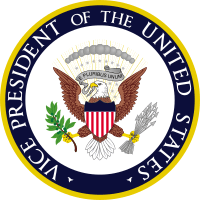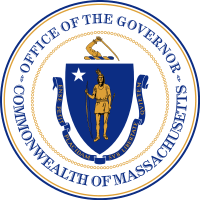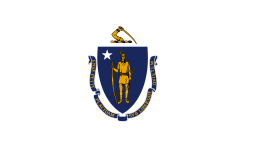Elbridge Gerry
| Elbridge Gerry | |
|---|---|
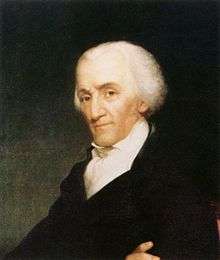 | |
| 5th Vice President of the United States | |
|
In office March 4, 1813 – November 23, 1814 | |
| President | James Madison |
| Preceded by | George Clinton |
| Succeeded by | Daniel D. Tompkins |
| 9th Governor of Massachusetts | |
|
In office June 10, 1810 – March 4, 1812 | |
| Lieutenant | William Gray |
| Preceded by | Christopher Gore |
| Succeeded by | Caleb Strong |
| Member of the U.S. House of Representatives from Massachusetts's 3rd district | |
|
In office March 4, 1789 – March 3, 1793 | |
| Preceded by | Constituency established |
| Succeeded by |
Shearjashub Bourne Peleg Coffin Jr. |
| Personal details | |
| Born |
Elbridge Thomas Gerry July 17, 1744 Marblehead, Massachusetts Bay, British America |
| Died |
November 23, 1814 (aged 70) Washington, D.C., U.S. |
| Resting place | Congressional Cemetery |
| Political party | Democratic-Republican |
| Spouse(s) | Ann Thompson |
| Children | 10 |
| Alma mater | Harvard University |
| Signature |
|
Elbridge Gerry (/ˈɡɛri/; July 17, 1744 (O.S. July 6, 1744) – November 23, 1814) was an American statesman and diplomat. As a Democratic-Republican he served as the fifth Vice President of the United States from March 1813 until his death in November 1814. He is known best for being the namesake of gerrymandering, a process by which electoral districts are drawn with the aim of aiding the party in power, although its initial "g" has softened to /dʒ/ rather than the hard /ɡ/ of his name.[1]
Born into a wealthy merchant family, Gerry vocally opposed British colonial policy in the 1760s, and was active in the early stages of organizing the resistance in the American Revolutionary War. Elected to the Second Continental Congress, Gerry signed both the Declaration of Independence and the Articles of Confederation. He was one of three men who attended the Constitutional Convention in 1787 who refused to sign the United States Constitution because it did not then include a Bill of Rights. After its ratification he was elected to the inaugural United States Congress, where he was actively involved in drafting and passage of the Bill of Rights as an advocate of individual and state liberties.
Gerry was at first opposed to the idea of political parties, and cultivated enduring friendships on both sides of the political divide between Federalists and Democratic-Republicans. He was a member of a diplomatic delegation to France that was treated poorly in the XYZ Affair, in which Federalists held him responsible for a breakdown in negotiations. Gerry thereafter became a Democratic-Republican, running unsuccessfully for Governor of Massachusetts several times before winning the office in 1810. During his second term, the legislature approved new state senate districts that led to the coining of the word "gerrymander"; he lost the next election, although the state senate remained Democratic-Republican. Chosen by Madison as his vice presidential candidate in 1812, Gerry was elected, but died a year and a half into his term. He is the only signer of the Declaration of Independence who is buried in Washington, D.C.
Early life
Elbridge Gerry was born on July 17, 1744, in Marblehead, Massachusetts. His father, Thomas Gerry, was a merchant operating ships out of Marblehead, and his mother, Elizabeth (Greenleaf) Gerry, was the daughter of a successful Boston merchant.[2] Gerry's first name came from John Elbridge, one of his mother's ancestors.[3] Gerry's parents had eleven children in all, although only five survived to adulthood. Of these, Elbridge was the third.[4] He was first educated by private tutors, and entered Harvard College shortly before turning fourteen. After receiving a B.A. in 1762 and an M.A. in 1765, he entered his father's merchant business. By the 1770s the Gerrys numbered among the wealthiest Massachusetts merchants, with trading connections in Spain, the West Indies, and along the North American coast.[2][5] Gerry's father, who had emigrated from England in 1730, was active in local politics and had a leading role in the local militia.[6]
Early political career
Gerry was from an early time a vocal opponent of Parliamentary efforts to tax the colonies after the French and Indian War ended in 1763. In 1770 he sat on a Marblehead committee that sought to enforce importation bans on taxed British goods. He frequently communicated with other Massachusetts opponents of British policy, including Samuel Adams, John Adams, Mercy Otis Warren, and others.[2]
In May 1772 he won election to the Great and General Court of the Province of Massachusetts Bay (its legislative assembly). There he worked closely with Samuel Adams to advance colonial opposition to Parliamentary colonial policies. He was responsible for establishing Marblehead's committee of correspondence, one of the first to be set up after that of Boston.[7] However, an incident of mob action prompted him to resign from the committee the next year. Gerry and other prominent Marbleheaders had established a hospital for performing smallpox inoculations on Cat Island; because the means of transmission of the disease were not known at the time, fears amongst the local population led to protests which escalated into violence that wrecked the facilities and threatened the proprietors' other properties.[8]
Gerry reentered politics after the Boston Port Act closed that city's port in 1774, and Marblehead became a port to which relief supplies from other colonies could be delivered. As one of the town's leading merchants and Patriots, Gerry played a major role in ensuring the storage and delivery of supplies from Marblehead to Boston, interrupting those activities only to care for his dying father. He was elected as a representative to the First Continental Congress in September 1774, but refused, still grieving the loss of his father.[9]
Congress and Revolution
Gerry was elected to the provincial assembly, which reconstituted itself as the Massachusetts Provincial Congress after Governor Thomas Gage dissolved the body in October 1774.[10] He was assigned to its committee of safety, responsible for assuring that the province's limited supplies of weapons and gunpowder remained out of British Army hands. His actions were partly responsible for the storage of weapons and ammunition in Concord; these stores were the target of the British raiding expedition that sparked the start of the American Revolutionary War with the Battles of Lexington and Concord in April 1775.[11] (Gerry was staying at an inn at Menotomy, now Arlington, when the British marched through on the night of April 18.)[12] During the Siege of Boston that followed, Gerry continued to take a leading role in supplying the nascent Continental Army, something he would continue to do as the war progressed.[13] He leveraged business contacts in France and Spain to acquire not just munitions, but supplies of all types, and was involved in the transfer of financial subsidies from Spain to Congress. He sent ships to ports all along the American coast, and dabbled in financing privateering operations.[14]

Unlike some merchants, there is no evidence that Gerry profiteered from this activity (he spoke out against it, and in favor of price controls), although his war-related merchant activities notably increased the family's wealth.[15] His gains were tempered to some extent by the precipitous decline in the value of paper currencies, which he held in large quantities and speculated in.[16]
Gerry served in the Second Continental Congress from February 1776 to 1780, when matters of the ongoing war occupied the body's attention. He was influential in convincing a number of delegates to support passage of the United States Declaration of Independence in the debates held during the summer of 1776; John Adams wrote of him, "If every Man here was a Gerry, the Liberties of America would be safe against the Gates of Earth and Hell."[17] He was implicated as a member of the so-called "Conway Cabal", a group of Congressmen and military officers who were dissatisfied with the performance of General George Washington during the 1777 military campaign. However, Gerry took Pennsylvania leader Thomas Mifflin, one of Washington's critics, to task early in the episode, and specifically denied knowledge of any sort of conspiracy against Washington in February 1778.[18]
Gerry's political philosophy was one of limited central government, and he regularly advocated for the maintenance of civilian control of the military. He held these positions fairly consistently throughout his political career (wavering principally on the need for stronger central government in the wake of the 1786–87 Shays's Rebellion) and was well known for his personal integrity.[19] In later years he was against the idea of political parties, remaining somewhat distant from the developing Federalist and Democratic-Republican parties until later in his career. It was not until 1800 that he would formally associate with the Democratic-Republicans in opposition to what he saw as attempts by the Federalists to centralize too much power in the national government.[20] In 1780 he resigned from the Continental Congress over the issue, and refused offers from the state legislature to return to the Congress.[21] He also refused appointment to the state senate, claiming he would be more effective in the state's lower chamber, and also refused appointment as a county judge, comparing the offer by Governor John Hancock to those made by royally appointed governors to benefit their political allies.[22] He was elected a Fellow of the American Academy of Arts and Sciences in 1781.[23]
Gerry was convinced to rejoin the Confederation Congress in 1783, when the state legislature agreed to support his call for needed reforms.[24] He served in that body until September 1785, during which time it met in New York City. The following year he married Ann Thompson, the daughter of a wealthy New York merchant who was twenty years his junior; his best man was his good friend James Monroe.[17][25] The couple had ten children between 1787 and 1801, straining Ann's health.[17]
The war made Gerry sufficiently wealthy that when it ended he sold off his merchant interests, and began investing in land. In 1787 he purchased the Cambridge, Massachusetts estate of the last royal lieutenant governor of Massachusetts, Thomas Oliver, which had been confiscated by the state. This 100-acre (40 ha) property, known as Elmwood, became the family home for the rest of Gerry's life.[26] He continued to own property in Marblehead, and bought a number of properties in other Massachusetts communities. He also owned shares in the Ohio Company, prompting some political opponents to characterize him as an owner of vast tracts of western lands.[27]
Constitutional Convention
Gerry played a major role in the U.S. Constitutional Convention, held in Philadelphia during the summer of 1787.[28] In its deliberations he consistently advocated for a strong delineation between state and federal government powers, with state legislatures shaping the membership of federal government positions. Gerry's opposition to popular election of representatives was rooted in part by the events of Shays's Rebellion, a populist uprising in western Massachusetts in the year preceding the convention. Despite this position, he also sought to maintain individual liberties by providing checks on government power that might abuse or limit those freedoms.[29] He supported the idea that the Senate composition should not be determined by population; the view that it should instead be composed of equal numbers of members for each state prevailed in the Connecticut Compromise. The compromise was adopted on a narrow vote in which the Massachusetts delegation was divided, Gerry and Caleb Strong voting in favor.[30] Gerry further proposed that senators of a state, rather than casting a single vote on behalf of the state, instead vote as individuals.[31] Gerry was also vocal in opposing the Three-Fifths Compromise, which counted slaves as 3/5 of a person for the purposes of apportionment in the House of Representatives and gave southern states a decided advantage.[32]
Advocating indirect elections
Because of his fear of demagoguery and belief the people of the United States could be easily misled, Gerry also advocated indirect elections. Although he was unsuccessful in obtaining them for the lower house of Congress, Gerry did obtain such indirect elections for the U.S. Senate, whose members were to be elected by the state legislatures. Gerry also advanced numerous proposals for indirect elections of the President of the United States, most of them involving limiting the right to vote to the state governors and electors.[34]
Voting against proposed constitution
Gerry was also unhappy about the lack of expression of any sort of individual liberties in the proposed constitution, and generally opposed proposals that strengthened the central government. He was one of only three delegates who voted against the proposed constitution in the convention (the others were George Mason and Edmund Randolph), citing a concern about the convention's lack of authority to enact such major changes to the nation's system of government, and to the constitution's lack of "federal features".[35]
State ratification; Bill of Rights
During the ratification debates that took place in the states following the convention, Gerry continued his opposition, publishing a widely circulated letter documenting his objections to the proposed constitution.[36] In this document he cited the lack of a Bill of Rights as his primary objection, but also expressed qualified approval of the constitution, indicating that he would accept it with some amendment.[37] Strong pro-Constitution forces attacked him in the press, comparing him unfavorably to the Shaysites. Henry Jackson was particularly vicious: "[Gerry has] done more injury to this country by that infamous Letter than he will be able to make atonement in his whole life",[36] and Oliver Ellsworth, a convention delegate from Connecticut, charged him with deliberately courting the Shays faction.[38] One consequence of the furor over his letter was that he was not selected as a delegate to the Massachusetts ratifying convention,[39] although he was later invited to attend by the convention's leadership. The convention leadership was dominated by Federalists, and Gerry was not given any formal opportunity to speak; he left the convention after a shouting match with convention chair Francis Dana.[40] The state ratified the constitution by a vote of 187 to 168.[41] The debate had the result of estranging Gerry from a number of previously friendly politicians, including chairman Dana and Rufus King.[42]
United States House of Representatives
Anti-Federalist forces nominated Gerry for governor in 1788, but he was predictably defeated by the popular incumbent John Hancock.[43] Following ratification, Gerry recanted his opposition to the Constitution, noting that a number of state ratifying conventions had called for amendments that he supported.[44] He was nominated by friends (over his own opposition to the idea) for a seat in the inaugural House of Representatives, where he then served two terms.[45]

In June 1789 Gerry proposed that Congress consider all of the proposed constitutional amendments that various state ratifying conventions had called for (notably those of Rhode Island and North Carolina, which had at the time still not ratified the constitution).[46] In the debate that followed, he led opposition to some of the proposals, arguing that they did not go far enough in ensuring individual liberties. He successfully lobbied for inclusion of freedom of assembly in the First Amendment, and was a leading architect of the Fourth Amendment protections against search and seizure.[47] He sought unsuccessfully to insert the word "expressly" into the Tenth Amendment, which might have more significantly limited the federal government's power.[48] He was successful in efforts to severely limit the federal government's ability to control state militias.[49] In tandem, with this protection, he had once argued against the idea of the federal government controlling a large standing army, comparing it – most memorably and mischievously – to a standing penis: "An excellent assurance of domestic tranquility, but a dangerous temptation to foreign adventure."[50]
Gerry vigorously supported Alexander Hamilton's reports on public credit, including the assumption at full value of state debts, and supported Hamilton's new Bank of the United States, positions consistent with earlier calls he had made for economic centralization.[51] Although he speculated in depreciated Continental bills of credit (the IOUs at issue), there is no evidence he participated in large-scale speculation that attended the debate when it took place in 1790, and he became a major investor in the new bank.[52] He used the floor of the House to speak out against aristocratic and monarchical tendencies he saw as threats to republican ideals, and generally opposed laws and their provisions that he perceived as limiting individual and state liberties. He opposed any attempt to give officers of the executive significant powers, specifically opposing establishment of the Treasury Department because its head might gain more power than the President.[53] He opposed measures that strengthened the Presidency (such as the ability to fire cabinet officers), seeking instead to give the legislature more power over appointments.[54]
Gerry did not stand for re-election in 1792, returning home to raise his children and care for his sickly wife.[55] He agreed to serve as a presidential elector for John Adams in the 1796 election.[56] During Adams' term in office, Gerry maintained good relations with both Adams and Vice President Thomas Jefferson, hoping that the divided executive might lead to less friction. His hopes were not realized: the split between Federalists (Adams) and Democratic-Republicans (Jefferson) widened.[57]
XYZ Affair

President Adams appointed Gerry to be a member of a special diplomatic commission sent to Republican France in 1797.[58] Tensions had risen between the two nations after the 1796 ratification of the Jay Treaty, made between the US and Great Britain. It was seen by French leaders as signs of an Anglo-American alliance, and France had consequently stepped up seizures of American ships.[59] Adams chose Gerry, over his cabinet's opposition (on political grounds that Gerry was insufficiently Federalist), because of their long-standing relationship; Adams described Gerry as one of the "two most impartial men in America" (Adams himself being the other).[58]
Gerry joined co-commissioners Charles Cotesworth Pinckney and John Marshall in France in October 1797 and met briefly with Foreign Minister Talleyrand.[60] Some days after that meeting, the delegation was approached by three French agents (at first identified as "X", "Y", and "Z" in published papers, leading the controversy to be called the "XYZ Affair") who demanded substantial bribes from the commissioners before negotiations could continue.[61] The commissioners refused, and sought unsuccessfully to engage Talleyrand in formal negotiations.[62] Believing Gerry to be the most approachable of the commissioners, Talleyrand successively froze first Pinckney and then Marshall out of the informal negotiations, and they left France in April 1798.[63] Gerry, who sought to leave with them, stayed behind because Talleyrand threatened war if he left.[64] Gerry refused to make any significant negotiations afterward and left Paris in August.[65] By then dispatches describing the commission's reception had been published in the United States, raising calls for war.[66] The undeclared naval Quasi-War (1798–1800) followed.[67] Federalists, notably Secretary of State Timothy Pickering, accused Gerry of supporting the French and abetting the breakdown of the talks, while Adams and Republicans such as Thomas Jefferson supported him.[68] The negative press damaged Gerry's reputation, and he was burned in effigy by protestors in front of his home. He was only later vindicated, when his correspondence with Talleyrand was published.[57] In response to the Federalist attacks on him, and because of his perception that the Federalist-led military buildup threatened republican values, Gerry formally joined the Democratic-Republican Party in early 1800, standing for election as Governor of Massachusetts.[69]
Governor of Massachusetts
For four years Gerry unsuccessfully sought the governorship of Massachusetts. His opponent in these races, Caleb Strong, was a popular moderate Federalist, whose party dominated the state's politics despite a national shift toward the Republicans.[70] In 1803 Republicans in the state were divided, and Gerry only had regional support of the party. He decided not to run in 1804, returning to semi-retirement[71] and to deal with a personal financial crisis. His brother Samuel Russell had mismanaged his own business affairs, and Gerry had propped him up by guaranteeing a loan that was due. The matter ultimately ruined Gerry's finances for his remaining years.[72]
Republican James Sullivan won the governor's seat from Strong in 1807, but his successor was unable to hold the seat in the 1809 election, which went to Federalist Christopher Gore.[73] Gerry stood for election again in 1810 against Gore, and won a narrow victory. Republicans cast Gore as an ostentatious British-loving Tory who wanted to restore the monarchy (his parents had remained Loyal during the Revolution), and Gerry as a patriotic American, while Federalists described Gerry as a "French partizan" and Gore as an honest man devoted to ridding the government of foreign influence.[74] A temporary lessening in the threat of war with Britain aided Gerry.[75] The two battled again in 1811, with Gerry once again victorious in a highly acrimonious campaign.[76][77]
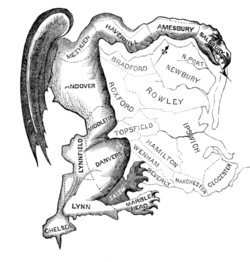
Gerry's first year as governor was less controversial than his second, because the Federalists controlled the state senate. He preached moderation in the political discourse, noting that it was important that the nation present a unified front in its dealings with foreign powers.[79] In his second term, with full Republican control of the legislature, he became notably more partisan, purging much of the state government of Federalist appointees. The legislature also enacted "reforms" of the court system that resulted in an increase in the number of judicial appointments, which Gerry filled with Republican partisans. Infighting within the party and a shortage of qualified candidates, however, played against Gerry, and the Federalists scored points by complaining vocally about the partisan nature of the reforms.[80]
Other legislation passed during Gerry's second year included a bill broadening the membership of Harvard's Board of Overseers to diversify its religious membership, and another that liberalized religious taxes. The Harvard bill had significant political slant because the recent split between orthodox Congregationalists and Unitarians also divided the state to some extent along party lines, and Federalist Unitarians had recently gained control over the Harvard board.[81]
In 1812 the state adopted new constitutionally mandated electoral district boundaries. The Republican-controlled legislature had created district boundaries designed to enhance their party's control over state and national offices, leading to some oddly shaped legislative districts.[82] Although Gerry was unhappy about the highly partisan districting (according to his son-in-law, he thought it "highly disagreeable"), he signed the legislation. The shape of one of the state senate districts in Essex County was compared to a salamander by a local Federalist newspaper in a political cartoon, calling it a "Gerry-mander".[83] Ever since, the creation of such districts has been called gerrymandering.[82] Gerry also engaged in partisan investigations of potential libel against him by elements of the Federalist press, further damaging his popularity with moderates. The redistricting controversy, along with the libel investigation and the impending War of 1812, contributed to Gerry's defeat in 1812 (once again at the hands of Caleb Strong, whom the Federalists had brought out of retirement).[84][85] The gerrymandering of the state senate was a notable success in the 1812 election: the body was thoroughly dominated by Republicans, even though the house and the governor's seat went to Federalists by substantial margins.[78]
Vice Presidency and death
Gerry's financial difficulties prompted him to ask President James Madison for a federal position after his loss in the 1812 election (which was held early in the year).[85] He was chosen by the Democratic-Republican party congress to be Madison's vice presidential running mate in the 1812 presidential election, although the nomination was first offered to John Langdon. He was viewed as a relatively safe choice who would attract Northern votes but not pose a threat to James Monroe, who was thought likely to succeed Madison. Madison easily won reelection, and Gerry took the oath of office at Elmwood in March 1813.[86] At that time the office of vice president was largely a sinecure; Gerry's duties included advancing the administration's agenda in Congress and dispensing patronage positions in New England.[87] Gerry's actions in support of the War of 1812 had a partisan edge: he expressed concerns over a possible Federalist seizure of Fort Adams (as Boston's Fort Independence was then known) as a prelude to Anglo-Federalist cooperation, and sought the arrest of printers of Federalist newspapers.[88]
On November 23, 1814, he fell seriously ill while visiting Joseph Nourse of the Treasury Department,[89] and died not long after returning to his home in the Seven Buildings.[90] He is buried in the Congressional Cemetery in Washington, D.C.,[91] with a memorial by John Frazee.[92] He is the only signer of the Declaration buried in the nation's capital.[93] The estate he left his wife and children was rich in land and poor in cash; he had managed to repay his brother's debts with his pay as vice president.[90] Aged 68 at the start of his Vice Presidency, he would be the oldest person to become Vice President until Charles Curtis in 1929.
Legacy
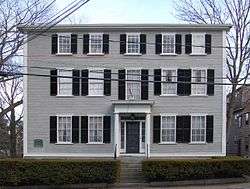
Gerry is generally remembered for the use of his name in the word gerrymander, for his refusal to sign the United States Constitution, and for his role in the XYZ Affair. His path through the politics of the age has been difficult to characterize; early biographers, including his son-in-law James T. Austin and Samuel Eliot Morison, struggled to explain his apparent changes in position. Biographer George Athan Billias posits that Gerry was a consistent advocate and practitioner of republicanism as it was originally envisioned,[94] and that his role in the Constitutional Convention had a significant impact on the document it eventually produced.[95]
Gerry had ten children, of which seven survived into adulthood: Gerry's son, James Thompson Gerry, commanded the USS Albany, a United States Navy war sloop that went down with all hands in 1854.[96]
- Catharine Gerry (1787–1850)
- Eliza Gerry (1791–1882)
- Ann Gerry (1791–1883)
- Elbridge Gerry, Jr. (1793–1867)[97]
- Thomas Russell Gerry (1794–1848), who married Hannah Green Goelet (1804–1845)[98]
- Helen Maria Gerry (1796–1864)
- James Thompson Gerry (1797–1854), who left West Point upon his father's death and was Commander of the war-sloop USS Albany (1846); the sloop disappeared with all hands 28 or 29 September 1854 near the West Indies.[99]
Gerry's grandson Elbridge Thomas Gerry became a distinguished lawyer and philanthropist in New York. His great-grandson, Peter G. Gerry (1879–1957), was a member of the U.S. House of Representatives and a United States Senator from Rhode Island.[100]
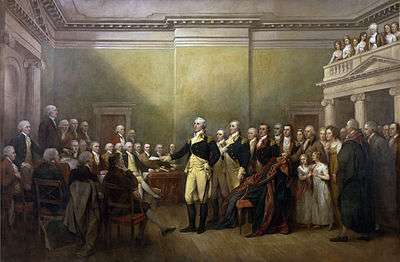
Gerry is depicted in two of John Trumbull's paintings, the Declaration of Independence and General George Washington Resigning His Commission.[102] Both are on view in the rotunda of the United States Capitol.[101]
The upstate New York town of Elbridge is believed to have been named in his honor, as is the western New York town of Gerry, in Chautauqua County.[103][104] The town of Phillipston, Massachusetts was originally incorporated in 1786 under the name Gerry in his honor, but was changed to its present name after the town submitted a petition in 1812, citing Democratic-Republican support for the War of 1812.[105]
Gerry's Landing Road in Cambridge, Massachusetts is located near the Eliot Bridge not far from Elmwood. During the 19th century, the area was known as Gerry's Landing (formerly known as Sir Richard's Landing), and was used by a Gerry relative for a short time as a landing and storehouse.[106][107] The supposed house of his birth, the Elbridge Gerry House (it is uncertain whether he was born in the house currently standing on the site or an earlier structure) stands in Marblehead, and that town's Elbridge Gerry School is named in his honor.[108][109]
In popular culture
Elbridge was mentioned in the final episode of Bojack Horseman season 5.
References
Notes
- ↑ Elster, p. 224
- 1 2 3 Purcell, p. 46
- ↑ Greenleaf, p. 77
- ↑ Billias, p. 5
- ↑ Billias, p. 4
- ↑ Billias, p. 3
- ↑ Austin, pp. 6–27
- ↑ Gilje, pp. 44–45
- ↑ Billias, pp. 42–44
- ↑ Billias, p. 46
- ↑ Billias, p. 49
- ↑ Billias, p. 52
- ↑ Billias, pp. 55–56
- ↑ Billias, pp. 124–30
- ↑ Billias, pp. 56, 123
- ↑ Billias, pp. 134–35
- 1 2 3 Hatfield, Mark. "Vice Presidents of the United States: Elbridge Gerry (1813–1814)" (PDF). Senate Historical Office. Archived (PDF) from the original on 2012-10-19. Retrieved 2012-10-24.
- ↑ Billias, pp. 76–77
- ↑ Billias, pp. 140, 152, 192
- ↑ Billias, p. 105
- ↑ Billias, p. 101
- ↑ Billias, p. 102
- ↑ "Book of Members, 1780–2010: Chapter G" (PDF). American Academy of Arts and Sciences. Archived (PDF) from the original on 2014-01-16. Retrieved July 28, 2014.
- ↑ Billias, p. 103
- ↑ Ammon, p. 61
- ↑ "National Register Nomination for Elmwood". National Park Service. Retrieved 2012-10-24.
- ↑ Billias, p. 137
- ↑ Billias, p. 158
- ↑ Billias, pp. 153–54
- ↑ Billias, p. 178
- ↑ Billias, p. 182
- ↑ Billias, p. 168
- ↑ Billias, p. 203
- ↑ https://www.archives.gov/publications/prologue/2006/spring/gerry.html Archived 2017-07-19 at the Wayback Machine. "A Founding Father in Dissent Elbridge Gerry Helped Inspire Bill of Rights in His Opposition to the Constitution". National Archives.
- ↑ Billias, p. 159, 200
- 1 2 Billias, p. 209
- ↑ Billias, pp. 207–08
- ↑ Billias, p. 212
- ↑ Billias, p. 211
- ↑ Billias, p. 213
- ↑ Billias, p. 214
- ↑ Billias, pp. 207–08, 213
- ↑ Billias, p. 215
- ↑ Billias, p. 207
- ↑ Billias, pp. 216, 243
- ↑ Billias, p. 229
- ↑ Billias, p. 231
- ↑ Billias, pp. 233–34
- ↑ Billias, p. 232
- ↑ Isaacson, Walter (2003). Benjamin Franklin: An American Life. New York, NY: Simon & Schuster. p. 456. ISBN 0-684-80761-0. Archived from the original on 2013-05-19. Retrieved 2013-05-24.
- ↑ Billias, pp. 223, 237
- ↑ Billias, pp. 240, 242
- ↑ Billias, p. 225
- ↑ Billias, p. 226
- ↑ Billias, p. 243
- ↑ Billias, p. 245
- 1 2 Purcell, pp. 51–52
- 1 2 Ferling, p. 345
- ↑ Elkins and McKitrick, pp. 537–38
- ↑ Stinchcombe, pp. 596–97
- ↑ Billias, pp. 268–69
- ↑ Billias, pp. 272–75
- ↑ Stinchcombe, pp. 598–613
- ↑ Billias, p. 280
- ↑ Billias, p. 283
- ↑ Ferling, pp. 354–57
- ↑ Smith, p. 130
- ↑ Billias, pp. 289–93
- ↑ Billias, pp. 289, 301
- ↑ Buel, pp. 39–44
- ↑ Billias, pp. 304–305
- ↑ Billias, pp. 305–06
- ↑ Buel, pp. 73–82, 103–04
- ↑ Billias, p. 313
- ↑ Buel, pp. 104–07
- ↑ Buel, pp. 116–17
- ↑ Formisano, p. 74
- 1 2 Griffith, pp. 72–73
- ↑ Buel, pp. 107–08
- ↑ Buel, pp. 144–47
- ↑ Formisano, p. 76
- 1 2 Hart, p. 3:458
- ↑ Billias, p. 317
- ↑ Buel, pp. 148–49
- 1 2 Billias, p. 323
- ↑ Billias, p. 324
- ↑ Billias, p. 327
- ↑ Morison, p. 2:57
- ↑ "To John Adams from Rufus King, 23 November 1814". archive.gov. Archived from the original on 2015-05-18. Retrieved 12 May 2015.
- 1 2 Billias, p. 329
- ↑ Purcell, p. 53
- ↑ "Search results for: Frazee John, page 2 - Collections Search Center, Smithsonian Institution". collections.si.edu. Archived from the original on 2013-12-31. Retrieved 2013-11-04.
- ↑ Roberts and Schmidt, p. 47
- ↑ Billias, p. 2
- ↑ Billias, p. 204
- ↑ Adams Family, Adams Family Correspondence, Volume 12, Harvard University Press, 2015, editor's note p. 20.
- ↑ "DIED". May 21, 1867. Retrieved 24 April 2017.
- ↑ Kestenbaum, Lawrence. "The Political Graveyard: Gerry family". politicalgraveyard.com. The Political Graveyard. Retrieved 14 September 2016.
- ↑ See U.S. Military and Naval Academies, Cadet Records and Applications, 1805–1908, National Archives and Records Administration (NARA); Washington, D.C.; U.S. Military Academy Cadet Application Papers, 1805–1866; Microfilm Serial: M688; Microfilm Roll: 3, File #1–108 and Unnumbered; 1814: James T. Gerry, 1814. Accessed 4 November 2015. (subscription required). See also Charles R. Hale Collection. Hale Collection of Connecticut Cemetery Inscriptions. Hartford, Connecticut: Connecticut State Library. Connecticut Headstone Inscriptions Vol 32, Transcription here Archived 2016-03-05 at the Wayback Machine.. Accessed 4 November 2015.
- ↑ "Biographical Abstract of Peter G. Gerry". United States Congress. Archived from the original on 2011-08-05. Retrieved 2012-12-08.
- 1 2 "General George Washington Resigning His Commission". Architect of the Capitol. Archived from the original on 2017-07-31. Retrieved 2018-01-23.
- ↑ Weir, pp. 66–67
- ↑ Beauchamp, p. 361
- ↑ Downs and Hedley, p. 187
- ↑ Marvin, pp. 220–21
- ↑ Publications of the Cambridge Historical Society, p. 85
- ↑ Bethell et al, p. 62
- ↑ "MACRIS Inventory: Elbridge Gerry House". Commonwealth of Massachusetts. Archived from the original on 2013-02-22. Retrieved 2012-12-08.
- ↑ "MACRIS Inventory: Eldridge[sic] Gerry School". Commonwealth of Massachusetts. Archived from the original on 2013-02-21. Retrieved 2012-12-08.
Sources
- Ammon, Harry (1990) [1971]. James Monroe: The Quest for National Identity. Charlottesville, VA: University of Virginia Press. ISBN 9780813912660. OCLC 20294950.
- Austin, James (1828–29). Life of Elbridge Gerry. Boston: Wells and Lily. OCLC 3672336. Volume 2 Austin was Gerry's son-in-law.
- Bethell, John; Hunt, Richard; Shenton, Robert (2004). Harvard A to Z. Cambridge, MA: Harvard University Press. ISBN 9780674012882. OCLC 492735502.
- Beauchamp, William (1908). Past and Present of Syracuse and Onondaga County, Volume 1. New York: S. J. Clark. OCLC 3151469.
- Billias, George (1976). Elbridge Gerry, Founding Father and Republican Statesman. McGraw-Hill Publishers. ISBN 0-07-005269-7.
- Buel, Richard (2005). America on the Brink. New York: Palgrave Macmillan. ISBN 9781403962386. OCLC 55510543.
- Downs, John Phillips; Hedley, Frederick (1921). History of Chautauqua County and its People, Volume 1. Boston: American Historical Society. OCLC 1215442.
- Elkins, Stanley; McKitrick, Eric (1993). The Age of Federalism. New York: Oxford University Press. ISBN 9780195068900. OCLC 26720733.
- Elster, Charles (2005). The Big Book of Beastly Mispronunciations. Boston: Houghton Mifflin. ISBN 9780618423156. OCLC 317828351.
- Ferling, John (1992). John Adams: A Life. Knoxville, TN: University of Tennessee Press. ISBN 0870497308.
- Formisano, Ronald (1983). The Transformation of Political Culture: Massachusetts Parties, 1790s–1840s. New York: Oxford University Press. ISBN 9780195035094. OCLC 18429354.
- Gilje, Paul (1999). Rioting in America. Bloomington, IN: Indiana University Press. ISBN 9780253212627. OCLC 185656124.
- Greenleaf, James (1910). Genealogy of the Greenleaf Family. Boston: F. Wood. OCLC 4652345.
- Griffith, Elmer (1907). The Rise and Development of the Gerrymander. Chicago: Scott, Foresman and Co. OCLC 45790508.
- Hart, Albert Bushnell (ed) (1927). Commonwealth History of Massachusetts. New York: The States History Company. OCLC 1543273. (five volume history of Massachusetts until the early 20th century)
- Marvin, Abijah (1879). History of Worcester County, Volume 2. Boston: C. F. Jewett. OCLC 1804192.
- Morison, Samuel Eliot (2006) [1913]. The Life and Letters of Harrison Gray Otis. Kessinger Publishing. ISBN 9781428606494. OCLC 706649803.
- Purcell, L. Edward (2010). Vice Presidents: A Biographical Dictionary. New York: Facts on File. ISBN 9781438130712. OCLC 650307529.
- Roberts, Rebecca Boggs; Schmidt, Sandra K (2012). Historic Congressional Cemetery. Charleston, SC: Arcadia Publishing. ISBN 9780738592244. OCLC 769988285.
- Smith, Jean Edward (1996). John Marshall: Definer Of A Nation. New York: Henry, Holt & Company. ISBN 9780805055108. OCLC 248101402.
- Stinchcombe, William (October 1977). "The Diplomacy of the WXYZ Affair". William and Mary Quarterly (34:590–617). JSTOR 2936184.
- Trees, Andy (2000). "Private Correspondence for the Public Good: Thomas Jefferson to Elbridge Gerry, 26 January 1799". The Virginia Magazine of History and Biography. Virginia Historical Society. 108 (3): 217–254. ISSN 0042-6636. JSTOR 4249849. Shows that Gerry ignored Jefferson's 1799 letter inviting him to switch parties.
- Weir, John (1901). John Trumbull: A Brief Sketch of his Life. New York: Charles Scribner's Sons. OCLC 2103628.
- Political Register and Congressional Directory. Boston: Houghton, Osgood. 1878. OCLC 1466601.
- Publications of the Cambridge Historical Society. Cambridge, MA: Cambridge Historical Society. 1920. OCLC 6177743.
Further reading
External links
- United States Congress. "Elbridge Gerry (id: G000139)". Biographical Directory of the United States Congress.
- Elbridge Thomas Gerry at Find a Grave
- Biography by Rev. Charles A. Goodrich, 1856
- A New Nation Votes: American Election Returns 1787–1825
- Delegates to the Constitutional Convention: Massachusetts (Brief Biography of Gerry)
- Gerry family archive at Hartwick College
| U.S. House of Representatives | ||
|---|---|---|
| New constituency | Member of the U.S. House of Representatives from Massachusetts's 3rd congressional district 1789–1793 |
Succeeded by Shearjashub Bourne Peleg Coffin Jr. |
| Party political offices | ||
| New political party | Democratic-Republican nominee for Governor of Massachusetts 1800, 1801, 1802, 1803 |
Succeeded by James Sullivan |
| Preceded by Levi Lincoln |
Democratic-Republican nominee for Governor of Massachusetts 1810, 1811, 1812 |
Succeeded by Joseph B. Varnum |
| Preceded by John Langdon Withdrew |
Democratic-Republican nominee for Vice President of the United States 1812 |
Succeeded by Daniel D. Tompkins |
| Political offices | ||
| Preceded by Christopher Gore |
Governor of Massachusetts 1810–1812 |
Succeeded by Caleb Strong |
| Preceded by George Clinton |
Vice President of the United States 1813–1814 |
Succeeded by Daniel D. Tompkins |

